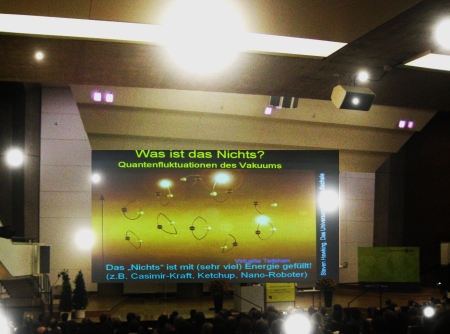Doctorow in the mudd club
April 9th, 2008
Holm Friebe, an unknown riesenmaschinist, Cory Doctorow and Martin Baaske alltogether in the mudd club
randformblog on math, physics, art, and design |

Holm Friebe, an unknown riesenmaschinist, Cory Doctorow and Martin Baaske alltogether in the mudd club
bldg blog had an interesting post about Chemical Geography. Among others bldg blog reports:
Between 1946 and 1970, approximately 47,800 large barrels and other containers of radioactive waste were dumped in the ocean west of San Francisco.The containers were to be dumped at three designated sites, but they litter a sea floor area of at least 1,400 km2 known as the Farallon Island Radioactive Waste Dump.
and
Somewhat ominously, at least from my perspective, the Farallon Islands are a short sail west by northwest from the neighborhood in which I’m writing this; on clear days you can even see them while hiking on the coast of Marin County.
moreover bldg blog cited the SF weekly, which investigated also on the case.
The report reminded me of the unexplained high rate of breast cancer in marine county. May be its time for a profound scientific investigation of the issue.
This is a mobile music edition of underestimated instruments:
we start this with a yellow drum machine (here is a description of this charming robot)
next we have of course the iphone / ipod touch:
iphone music using
iPhone Synth, BeatPhone, pianist, and the incredible
Pocket Guitar
(here is an even older one where the drum part is taken by a nintendo ds)
then there is the anouncement of a nice virtual Korg MS10 (I had the joy of playing with one of them once) for DS:
DS10 (video)
as a sideremark (since here the devices don’t make a sound but controll it):
iphone controls protools
and ableton live controlled by a PSP.
this is an update to underestimated instruments 4

Mixing musical styles can have interesting results. Here is a classic rock song with traditional japanese instruments and a little help of a classical (western european style) orthestra: we will rock you. (And there is smoke on the water as well.)
via japan probe.
Sideremark: We once performed Bizets Habanera from the Carmen opera on three chinese Shengs a cello and a clarinet.

Albino Cipriani a friend of my sister Anuschka and me put his new architecture website online. By the image one can see that he likes even, homogenous, light and open architectural spaces.
The instantreality-framework is a high-performance Mixed-Reality (MR) system, which combines various components to provide a single and consistent interface for AR/VR developers. Those components have been developed at the Fraunhofer IGD and ZGDV in close cooperation with industrial partners.
In theory it should be impossible to separate the notes in a chord. If you play a sine wave and add say a perfect 5th one perceives this either as a single note (now with a different timbre than the single sine wave) or as an interval – namely the perfect 5th. what one hears depends on several things. If for example both sine waves are given a slight vibrato of the same phase and rate one is more likely to hear this a one note. However in general it should be impossible to tell (algorithmically) whether the audiosignal is a chord or a timbre. Theoretically. In practice chords are allmost never tuned perfectly, the notes in a chord are likely to start with tiny (or even big) offsets, the instruments / strings / sources usually have their own characteristics. So it might be possible in practice to separate the notes in a chord. Still it should be a difficult task.
Now celemony – the company that makes the incredible Melodyne – anounced that they have takled the problem.
Here is a promo video that shows the possibilities (they use the slightly overused DNA acronym for their technology (this time as “direct note access”)) .
Impressive and somewhat scary.

Just an update on the pioneer effect and a similar sofar unexplained effect called fly-by anomaly. The fly-by anomaly occurs sometimes in socalled gravitational slingshots . A gravitational slingshot manoeuvre means to choose a spacecraft trajectory, which passes in such a way by a planet or a sun that the spacecraft experiences acceleration or deceleration. (Here a nice animation).
The fly-by anomaly says that in certain slingshot manoeuvres around the earth the corresponding space craft experienced an acceleration, which could not be accounted for by standard computations. The deviaton is small, but persistent. However the computations are quite complicated and it is already astonishing how precise researchers can nowadays predict spacecraft trajectories. And there better be no error in the computations! Just imagine if someone would for example confuse the various meridians…then in such a case a poor spacecraft could of course be burned by the sun before it ever reaches it. :)
Jet Propulsion Laboratory astronomer John Anderson gave an interview to space.com:
“I am feeling both humble and perplexed by this,” said Anderson, who is now working as a retiree. “There is something very strange going on with spacecraft motions. We have no convincing explanation for either the Pioneer anomaly or the flyby anomaly.”
and to the planetary society he said:
“It was time,” he said, “to tell people that there was a problem with earth flybys.” If the engineers at JPl couldn’t’ explain the effect, perhaps the broader scientific community could come up with an explanation.”
->article by Anderson in Physical Review letters
->talk on pioneer anomaly and fly-by effect at the Physikalisches Kolloquium, OvG–Universit¨t Magdeburg, 17.1.2007
As I received no protests – the article “On the need for a global academic internet platform” is now in the arxiv at : http://arxiv.org/pdf/0803.1360v1
To be precise: I only received NO comments at all.
But I see that xkcd already started an experts database on kilobytes :)
Any suggestions on where I could send the article to (without any extra costs) are welcome.
The below link contains an article in which I explain why I think that there is a necessity for a global academic internet platform. Most parts of the paper were already presented here on the blog. I now included the economy part to the earlier
version and made some additions. In particular I added a physics related remark concerning the constancy of natural constants and some thoughts on the diamond water paradox and on the price of digital items.
I put this here on the blog in order to enable people to add last-minute remarks, so it is still a draft but I envisage it as a final version and i will try to submit it somewhere.